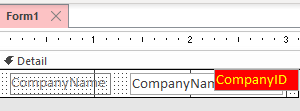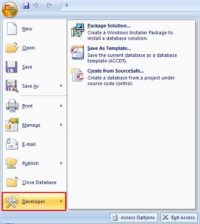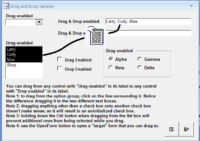Hardware matters. Invest in a faster PC and your Microsoft Access databases will run faster. Be alert for sellers packaging fast processors with minimal memory and a slow hard drive to keep prices low. Look at all aspects of the purchase when database speed is a priority. A faster hard drive is worth the investment…
Access NZ() function to SQL Server equivalent
What is the SQL Server equivalent to Access NZ() function? Access SQL NZ([Event Timestamp]) SQL Server Equivalent COALESCE([Event Timestamp],0) ISNULL([Event Timestamp],0) * do not confuse this with the Access isnull() function.
Use controls, not fields
Sometimes we need to use fields from a RecordSource that aren’t shown on the form. It is legal to reference them directly even if they don’t have a control. For example, we can have a form bound to a RecordSource like so: SELECT c.CompanyID, c.CompanyName FROM Companies; And only display CompanyName in a textbox but…
Hiding the Navigation Pane with VBA
Once you have created an Access Database Application to be used by other people, it may well be important for you to prevent users from gaining access to any of its design features. By this I mean, you may not want users to modify your tables, forms and queries etc in design view (inadvertently or…
Minimizing stateful code
First we need to define what a state is. A state means that the object has variable(s) that may cause it to behave differently, depending on the content of the variables. As an example, the Forms collection is stateful: Forms(“SomeForm”).Visible = False This is legal code and will compile but we can’t be assured that…
Access 2007: Access Developer Extensions
The Microsoft Office Access 2007 Developer Extensions make it easy to deploy and manage solutions built using Microsoft Access. The Access 2007 Developer Extensions provide packaging and deployment tools and licensing and distribution agreements to make it easier for developers to bring solutions to market. Whether you are working in a small business or a…
IS NULL: Understanding and Using the Null Value in Microsoft Access
In Microsoft Access, a null value is a value that is not assigned or unknown. When working with databases, it’s important to understand how to use and identify null values in order to ensure accurate and efficient data management. The IS NULL operator is one of the most useful tools for working with null values…
Drag & Drop and Conditional Sorting in Microsoft Access
Drag and Drop In MS Access Doug was on a roll in January of 2004 when he wrote his article on drag and drop in MS Access. He tested it now using Access 2016 and it still works. This article shows you how to add drag-and-drop to your Access application using combinations of multi-value and…
Use properties instead of constant or magic numbers
A common programming mistake is to hard-code literals that corresponds to some property. That is particularly true with certain controls like tab controls & pages. The tab control exposes a Value property that indicates the current tab and the pages contains a PageIndex property that indicates its position in the tabs of the control. Thus,…
Pivoting a dynamic set
SQL Server does not allow for a dynamic set, which can be problematic if you need to pivot based on the data that comes from rows and you can have various values in the column. In general, you need a stored procedure and dynamic SQL in order to handle the dynamic pivots. This requires uses…





